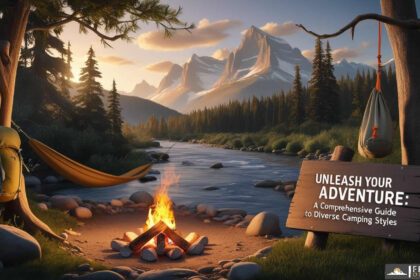
This article covers various camping styles, from traditional tent camping to luxurious glamping, and find the perfect fit for your outdoor adventure.
Overview of Camping Styles and Their Evolution
Camping has evolved dramatically over the years, transitioning from a hardcore outdoor pursuit primarily embraced by enthusiasts to a diverse activity appealing to a much broader audience. The transformation has been heavily influenced by social media, which has redefined how people perceive and document their outdoor experiences. Platforms like Instagram and Pinterest have popularized various camping styles, showcasing everything from traditional tent camping to luxurious glamping, which in turn affects how potential campers plan their adventures. The rise of hashtags like #vanlife illustrates a cultural shift where outdoor living is not just a hobby but a lifestyle choice celebrated through stunning visual storytelling.
This evolution signifies a broader change in how we engage with nature, emphasizing accessibility, enjoyment, and comfort over the rugged survivalist mentality that once dominated the camping culture. With a wide range of styles available, individuals can now select experiences tailored to their preferences, whether they are seasoned adventurers or casual weekend warriors. This inclusivity encourages more people to engage with the great outdoors, ultimately fostering a greater appreciation for nature and environmental conservation.
Tent Camping
Tent camping remains one of the most popular and versatile styles of camping, providing campers the freedom to set up their accommodations almost anywhere—from front-country campsites with facilities to secluded backcountry locations deep in the wilderness. This style is especially important for families, as it allows them to create a comfortable and engaging outdoor experience while emphasizing the need for careful site selection. For example, Pokagon State Park in Indiana, known for its scenic beauty and nearly 300 campsites, offers amenities that make it an ideal spot for families looking to balance nature with comfort. Families can enjoy activities like biking and swimming in the park’s lakes, making it a well-rounded camping destination.
Tent camping not only caters to those seeking an authentic outdoor experience, but it also allows for varying levels of comfort based on the camper’s preferences. Campers can opt for primitive experiences in remote areas, where they must rely on their skills and knowledge, or choose sites equipped with essential amenities like restrooms, picnic tables, and water sources [4]. This flexibility lets individuals tailor their camping adventure to their comfort level and experience, making it appealing to both novice and seasoned campers alike. Whether it’s a weekend getaway or an extended stay, tent camping offers an enriching way to connect with nature and create lasting memories.
RV Camping
For those who prefer the comforts of home while still enjoying the great outdoors, RV camping is an excellent choice. This style provides a unique blend of modern conveniences—such as kitchens, bathrooms, and even entertainment systems—making it especially suitable for families and beginners who may be apprehensive about traditional camping. Popular RV camping destinations like Cove Palisades State Park in Oregon offer a variety of activities, from water sports to hiking, ensuring that there’s something for everyone to enjoy. Families can even engage in fishing or kayaking, enhancing their outdoor experience while having access to the comforts of an RV.
The combination of outdoor experiences with the comforts of home makes RV camping an accessible option for casual campers. Many RV parks feature communal amenities such as pools, laundry facilities, and recreational areas, which add to the overall experience and make it easy to socialize with fellow campers. This camping style is ideal for longer trips, allowing families to travel together without sacrificing comfort or convenience. For example, Jack Hill State Park in Georgia is known for its fishing opportunities and mini-golf, making it a fun destination for families looking to mix relaxation with recreational activities.
Hammock Camping
Hammock camping has gained popularity among minimalist campers and spontaneous adventurers who appreciate the simplicity and lightweight nature of this style. By using trees for setup, campers can easily create a cozy sleeping space that offers exceptional ventilation and comfort during warm months. Modern hammocks come equipped with bug nets and rain covers, providing a versatile sleeping arrangement that can be adapted to various weather conditions. This makes hammock camping an attractive option for those who want to travel light and enjoy the flexibility of changing locations. For instance, a hammock can be conveniently packed in a backpack, allowing campers to explore remote sites without the burden of heavy gear.
Hammock camping is particularly well-suited for warm climates, where the open design allows for cooling breezes, making it a comfortable choice during summer outings. Campers can enhance their experience by combining the hammock with a tarp for additional rain and wind protection, ensuring that they remain dry and comfortable even in less-than-ideal weather. Moreover, hammock camping encourages a more spontaneous approach to camping, as individuals can quickly set up their sleeping quarters in a variety of environments. This spontaneity can lead to unique camping experiences, such as falling asleep to the sounds of nature while suspended among the trees.
Backpacking
Backpacking incorporates both hiking and camping, requiring self-sufficiency, lightweight gear, and careful planning of supplies. This style is ideal for individuals seeking adventure and a more immersive experience in nature. Recommended locations for backpacking trips, such as Colorado Bend State Park and Crowders Mountain State Park, provide excellent trails and breathtaking scenery for hikers and campers alike. Backpacking allows adventurers to explore areas that are often unreachable by vehicle, deepening their connection to the natural world.
The nature of backpacking trips can vary significantly, from overnight excursions to multi-day adventures, depending on the camper’s experience level and preferences. Essential gear for backpacking includes a lightweight tent, sleeping bag, portable cooking equipment, and navigational tools. Each piece of gear is carefully chosen to minimize weight while maximizing functionality, which is crucial for a successful backpacking experience. Additionally, the skills gained through backpacking—such as navigation, packing efficiently, and outdoor cooking—further enrich the overall experience and prepare individuals for future adventures.
Glamping
Glamping, a term that combines “glamorous” and “camping,” merges the comforts of luxury accommodations with the beauty of nature, making it an increasingly popular option for those who want to enjoy the outdoors without sacrificing modern conveniences. This style is perfect for individuals and families seeking unique experiences that prioritize comfort and style. Popular glamping sites like Platte River State Park and Watch Hill Fire Island provide luxurious accommodations ranging from yurts to safari tents, often equipped with amenities like gourmet meals and guided activities. This fusion of luxury and nature offers a new perspective on camping, appealing to those who might otherwise shy away from traditional outdoor experiences.
Glamping not only caters to those looking for a unique outdoor experience, but it also allows campers to enjoy nature without the hassle of setting up traditional camping gear. With options that include everything from cozy cabins to lavish tents, glamping can accommodate various preferences and budgets. Additionally, many glamping sites focus on sustainability and eco-friendly practices, allowing guests to enjoy their stay while minimizing their environmental impact. This makes glamping an excellent choice for individuals and families who want to reconnect with nature without compromising on comfort.
Family Camping
Family camping focuses on creating welcoming environments that cater to all ages, ensuring that everyone—from toddlers to grandparents—can enjoy the outdoor experience. Campsites like Lake Cascade State Park in Idaho enhance accessibility and comfort, offering amenities such as swimming pools, playgrounds, and organized activities designed for families. These features make it easier for families to bond and create lasting memories in nature, as they engage in activities like fishing, hiking, and nature trails that are suitable for all skill levels.
Camping together as a family also fosters educational opportunities, such as learning about local wildlife and ecosystems through organized programs and guided hikes. Families can participate in activities that promote teamwork and cooperation while exploring the great outdoors, which can be a rewarding experience. For instance, many family camping sites offer ranger-led programs that teach children about environmental conservation and the importance of preserving nature for future generations. This educational aspect enriches the camping experience, helping families develop a deeper appreciation for the natural world.
Survival Camping
Survival camping pushes campers to their limits, requiring a combination of skills in hunting, navigation, and self-sufficiency in challenging terrains. This style is designed for those with prior experience and knowledge of outdoor survival techniques, making it less suitable for beginners. Campers often prepare for wilderness survival with minimal gear, focusing on essential items that will help them thrive in the wild. The skills developed during survival camping can include fire-building, foraging, and shelter construction, which contribute to a deeper understanding of the natural environment and one’s abilities.
Survival camping not only tests physical endurance but also encourages personal growth and resilience as individuals learn to rely on their instincts and adapt to changing conditions. Many survival camping enthusiasts engage in workshops or courses to hone their skills further, providing a safe environment in which to practice techniques before venturing into the wild. Additionally, this style of camping fosters a profound sense of connection with nature, as individuals learn to appreciate the resources available to them and the importance of minimal impact on the environment.
Winter Camping
Winter camping presents unique challenges and rewards, requiring specialized gear designed to handle freezing temperatures, making it more suitable for seasoned campers. This camping style emphasizes solitude, offering a unique opportunity to experience the beauty of winter landscapes away from the crowds. Recommended practices for winter camping include using insulated tents, layering clothing, and learning snow safety techniques to ensure a safe and enjoyable experience. Activities during winter camping can range from snowshoeing and ice fishing to winter hiking, providing a diverse array of experiences in a snowy environment that are both exhilarating and peaceful.
One of the most significant aspects of winter camping is the preparation required to ensure safety and comfort in harsh conditions. Essential gear includes thermal clothing, cold-weather sleeping bags, and specialized cooking equipment that can function in freezing temperatures. Many winter campers also invest in high-quality gear to maximize their comfort and reduce the risk of hypothermia or frostbite. For those willing to embrace the cold, winter camping can be a magical experience, allowing individuals to witness breathtaking winter vistas and the tranquility of snow-covered landscapes.
Bike Camping
Bike camping combines the exhilaration of cycling with the adventure of camping, promoting environmental consciousness and physical fitness. This style allows campers to explore remote areas while packing essential gear on their bikes, making it a fantastic way to experience nature while staying active. Popular routes for bike camping may include scenic trails that accommodate both biking and camping, making it easy to plan trips that offer a mix of exploration and relaxation. For example, the Great Allegheny Passage offers a stunning route for cyclists, complete with access to campgrounds and breathtaking views.
The community aspect of bike camping is another appealing feature, as it encourages social engagement through organized group rides and events. Many bike camping enthusiasts plan trips together, fostering camaraderie and shared experiences while navigating scenic routes. Essential gear for bike camping includes a sturdy bike, panniers for packing, and lightweight camping equipment, ensuring that cyclists have everything they need for a successful journey. This camping style not only promotes fitness but also encourages eco-friendly practices, as individuals can experience the beauty of nature while reducing their carbon footprint.
Choosing the Right Camping Style
Choosing the right camping style should be a thoughtful process based on personal preferences, experience level, and desired amenities. When selecting a camping style, consider factors such as location, accessibility, and available gear, as well as how well each style aligns with your interests—whether they lean towards adventure, relaxation, or educational experiences. Engaging in research about specific campgrounds and their offerings can greatly assist in making an informed decision. Visiting websites that provide detailed information about different campgrounds can help you understand what to expect, including amenities and activities available at each site.
Connecting with fellow campers can provide valuable insights into different styles, helping individuals discover what suits them best. Online forums and social media groups dedicated to camping can offer recommendations and personal experiences that guide your decision-making process. By exploring various camping experiences, campers can build skills and confidence while enjoying the great outdoors, ultimately leading to more fulfilling and enjoyable adventures.
Recap and Exploration of Camping Styles
The diverse world of camping offers a range of styles, each with unique features that cater to different preferences and experiences. From traditional tent camping to luxurious glamping, there is a camping style for everyone to enjoy, ensuring that individuals can find an experience that resonates with them. As you explore these options, it’s essential to consider your comfort, safety, and personal interests to find the most suitable camping experience. Embracing different styles not only enhances outdoor adventures but also fosters a deeper appreciation for nature and the skills needed to navigate it. By trying out various approaches to camping, you can enrich your outdoor experiences while building memories that will last a lifetime.

